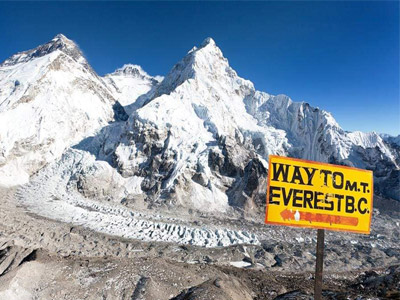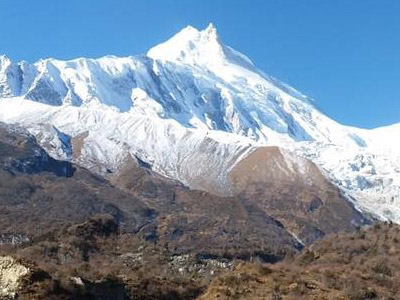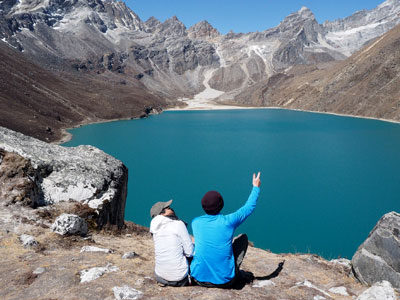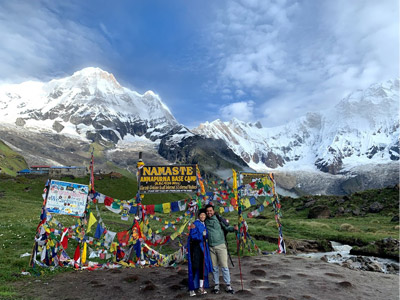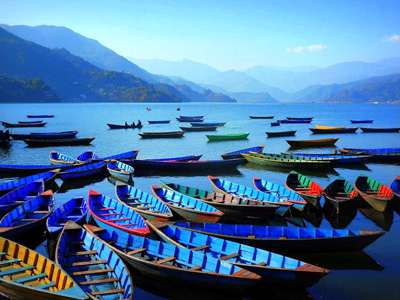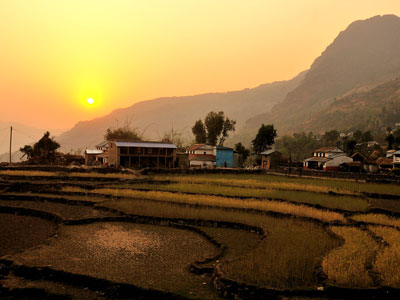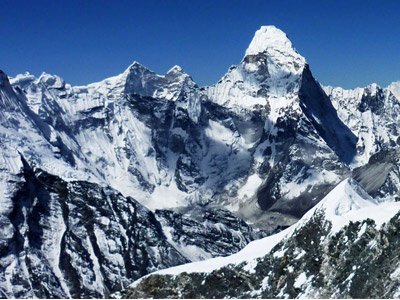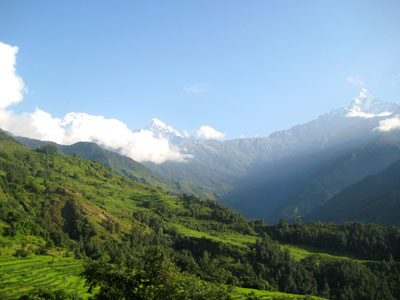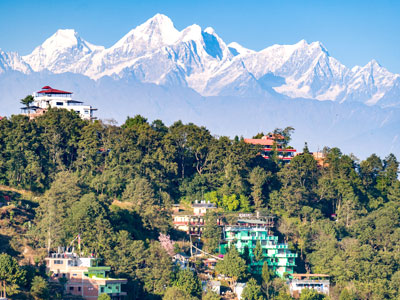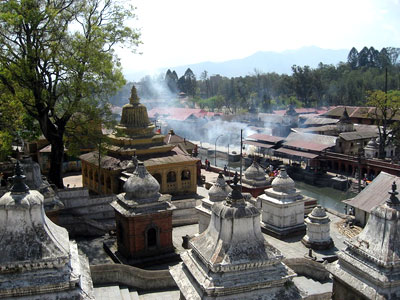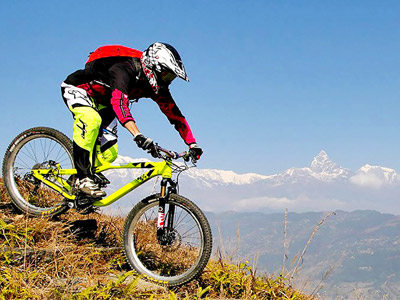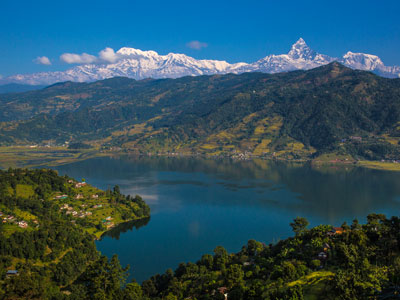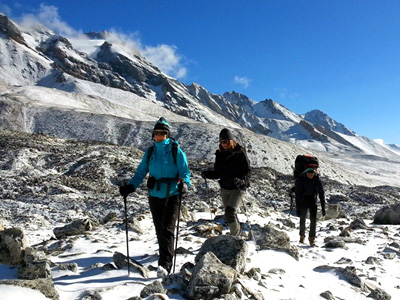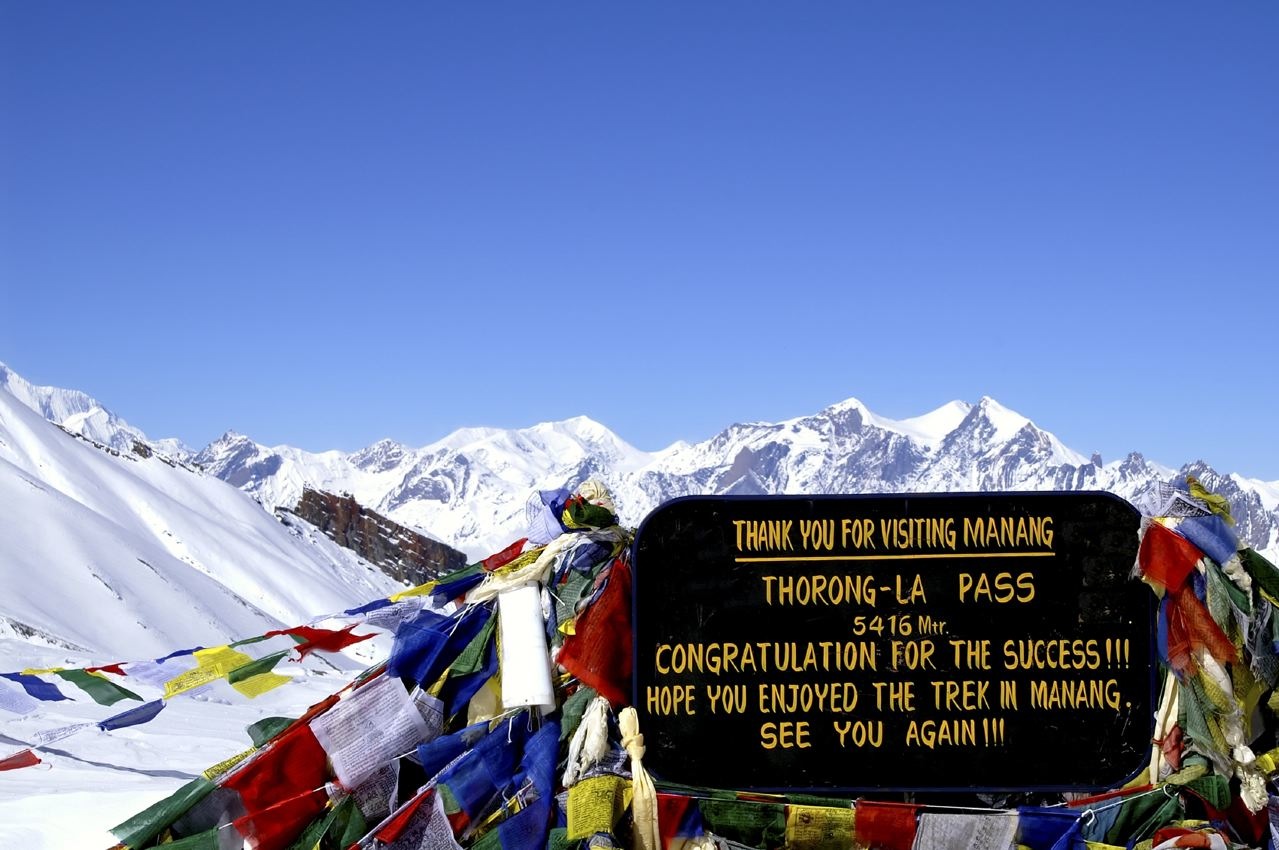
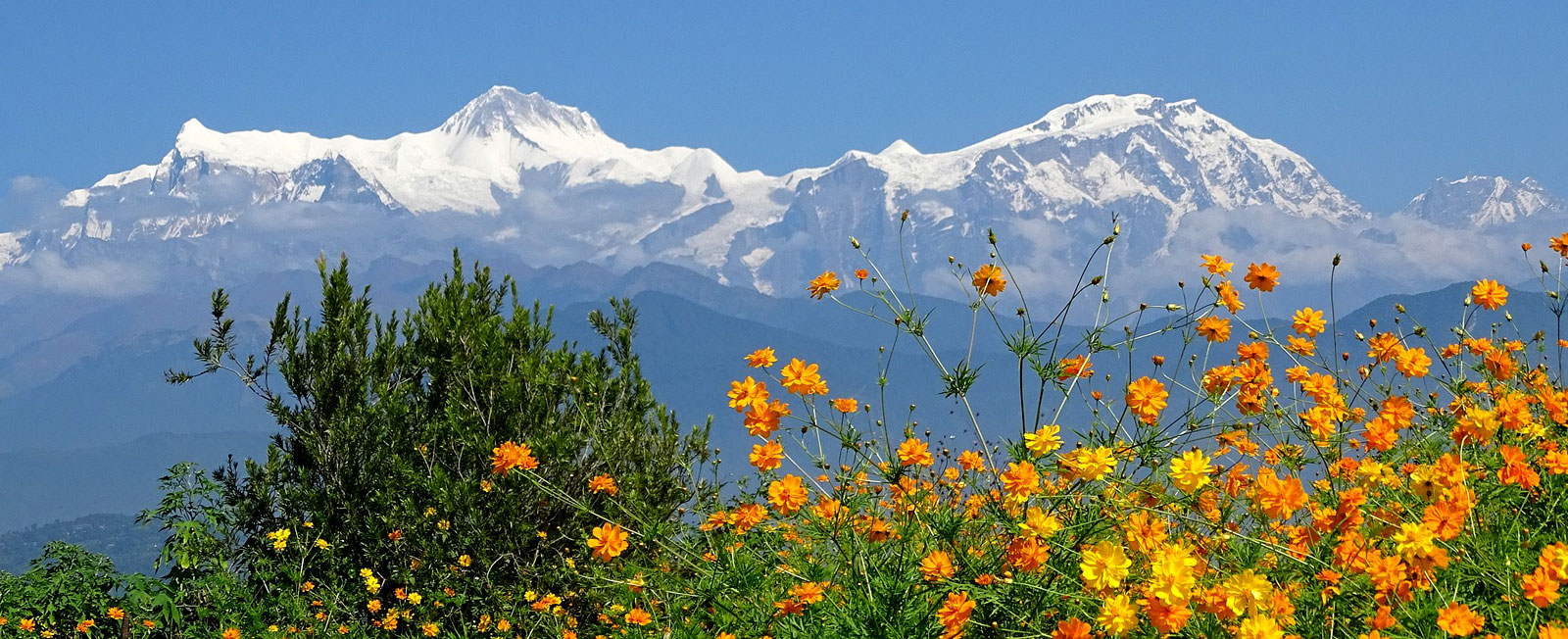
Annapurna Circuit Trek
Duration: 20 Days Trip Difficulty: Moderate
Trip Duration 20 Days
Destination Nepal
Group Size 2-12 People
Accomodation Hotel and Tea house
Altitude5416
Highlights of Annapurna Circuit Trek
- One of the most classic and oldest treks of Nepal
- Sightseeing of Kathmandu valley, the center of historical art and architecture with seven UNESCO recognized heritage sites.
- Thorang la pass, the highest navigable pass (5416m) in the world
- Muktinath, a holy temple and a proof of religious harmony between Hindu and Buddhist pilgrimage.
- Marsyangdi River Valley, Kaligandaki Valley, Jomsom valley, with its antique vibe and strong winds
- Descend into one of the deepest gorge’s in the world – the Kali Gandhaki
- Marpha with its apple orchards, apple candy, pie, and brandy
- Poon Hill Sunrise and Sunset 360-degree panoramic views of world’s highest mountains i.e. Mt. Dhauulagir (7th), Manaslu-(8th) , Annapurna I-(10th)
- Natural hot spring of Tatopani
- Traditional Gurung, Tibetan and other ethnic villages with warm hospitality of the people
Overview of Annapurna Circuit Trek
Annapurna Circuit Trek is the perfect choice for immersing oneself in nature, offering a wide range of altitude, landscape, flora and fauna, lakes, glaciers, gorges, stunning water fall and breath taking mountain views.
This trek allows for an authentic experience of the natural world with encounter in a variety of environment from challenging to easy, heart breaking to breath taking and everything in between.
The Annapurna Circuit Trek provides an opportunity to experience all kind of weather condition, vegetation, and reach traditions and culture of Nepalese people.
Nepal is an unique country with an unequal distribution of geographical region and varying altitude, ranging from 60m to 8848m above sea level. Despite of its small size, Nepal boasts the top 10 highest mountains in the world.
The Annapurna Circuit trek trial is situated in the in the mountain region of Nepal, providing opportunities to view some of the highest mountains in the region, such as Mt. Annapurna I, Mt Annapurna II, Thorung peak, Nilgiri, Chulu east and chulu west, Tukuche peak, Mt. Dhawalagiri and Lamgung Himal.
During the Annapurna Circuit Trek trekkers will travel through different vegetation forest, gorges lakes and glaciers, offering an opportunity to live in the nature. The forest full of rhododendron, oak tree, and bamboo tree below the snow line provide ample opportunity to explore different flora and fauna.
Travelling through the world’s deepest gorge the kali Gandaki gorge also known as ‘Aandha Galchi’, offers the unique experience. The Thorong La pass (5410m) highest pass, which links the Kali Gandaki and Marsangdi Valley, provides splendid views of the snowcapped Himalayas from the peak, which is beyond expectation.
Travelling close to the mountains is a different experience that one can only experience in Nepal. The glacier in the higher mountains, lakes like Tilicho lake and Gangapurna lake, will leave trekkers awestruck.
The view of lakes at the bottom of the Himalayas is heart touching, while glacier between the mountains hold different values, belief, and aspects. One can also take dip in natural hot springs in Tatopani. Experience such glacier lakes in the Annapurna Circuit trek is a once in a life time opportunity.
The Annapurna circuit trek takes trekkers through jungles, bare land and the Himalayas. The close view of mountains and sunrise over the Himalayas provides a peaceful and joyful vibes that relieves tension from the outer world.
This helps to live the real life with the nature, as crystal clear view of red, green and colorful forest below the snowline, green grasslands below the snow line, and shiny snow-covered mountains provide a heavenly feel.
Muktinath temple, one of the famous destinations among Hindu and Buddhist religious people, is also included in Annapurna Circuit Trek. Muktinath temple is well known for its 108 stone taps and eternal flame. Manang district is also famous for its beautiful landscape.
The Annapurna Circuit trek is not only famous for natural beauty but also for the best hospitality of local people. The traditions and culture of Gurung, Magar, Thakali people of Manang and mustang is also very famous for and attract the national and international tourist. The local food of Thakali is also known nationally aka ‘Thakali khana’.
Graceful Adventure Pvt. Ltd. Is an adventure travel company based in Nepal Kathmandu and Pokhara. We are committed to delivering an exceptional experience to our guests. Our unwavering commitment excellence has earned us the admiration of our clients and we are devoted to meeting the demands and expectations of our esteemed guests. We extend a warm invitation to you to join us our expeditions and explore the magnificence of the Himalayas.
Annapurna Circuit Trekking Route
Upon your arrival at Tribhuvan International Airport in Kathmandu, our Annapurna Circuit Trek will begin. A representative of our firm will be waiting to pick you up from the airport and transport you to your hotel. The following day, we will start our exploration of the Kathmandu Valley, a UNESCO World Heritage Site that is home to Pashupatinath, Swayambhunath, Boudhanath, and Kathmandu Durbar Square.
On the third day, we will embark on a six-hour drive to Besisahar, where our main trek to the Annapurna Circuit Trek will commence. After spending one night in Besisahar, we will proceed to Chamje, where we will witness stunning waterfalls and breathtaking views of the Lamjung Himal.
The next day, we will trek from Chamje to Bagarchhap.
The day after that, we will continue our ascent to Chame, passing by magnificent mountains such as Mt. Annapurna and Mt. Manaslu. From there, we will trek through a jungle full of rhododendron, oak, and bamboo to Pisang. After spending a night in upper Pisang, we will head to Manang, a drier region of Nepal, for an overnight stay.
After a day of acclimatization in Manang, we will embark on a steep climb through alpine and juniper forests, leaving the Marsyangdi River behind and passing through several charming settlements. Along the way, we will be treated to breathtaking views of towering mountains, including Annapurna and Tilicho Peak, before reaching our destination at Yak Kharka.
We will then trek to Thorong Phedi, which may prove to be a challenging day. The following day, we will trek to Muktinath Temple in Mustang, passing through the world’s highest pass, Thorong La Pass, located at an altitude of 5416 m. After spending the night in Mustang, we will visit Muktinath Temple, a famous religious site for both Hindu and Buddhist people, before moving on to Jomsom and Marpha, known for its apple orchards and ‘Marphali shau’ apples.
We will trek downhill to Ghasa before continuing our descent to Tatopani, where we can soak in natural hot springs. After spending the night in Tatopani, we will trek uphill to Ghorepani. The following morning, we will make an early start and hike to Poon Hill to witness a picture-perfect sunrise. We will then have lunch before driving back to Pokhara and stay in Pokhara Lakeside. And returning to Kathmandu the next day. Our trek concludes in Kathmandu.
Typical Day in Annapurna Circuit Trek
We will commence our trekking day with great enthusiasm, serving a delicious breakfast between 7 and 7:30 am, which will provide our guests with the much-needed energy for the next leg of their journey. Our team will embark at 8 am, and after trekking for 4 hours, we will arrive at our next destination, taking ample breaks to admire the awe-inspiring scenery.
To ensure that our guests are comfortable and avoid any physical strain, we have allocated sufficient rest time during the 6 to 7 hours of daily trekking. Around midday, we will stop for a well-deserved lunch, allowing our guests to rejuvenate themselves and appreciate the surrounding natural beauty. The one day while crossing the Throng La Pass we wake up around 3 am and start the trekking 3:30 am to till 2:00 Pm. That is the challenging and hardest day of Annapurna Circuit Trek.
In the evening, we will offer our guests a delectable dinner served between 6 to 7 pm, featuring a variety of local and international cuisine. Our team of expert chefs will use fresh, locally-sourced ingredients to create an unforgettable dining experience for our guests. With our exceptional hospitality and attention to detail, we are committed to making our guests’ trekking experience an enjoyable and memorable one.
Best time to Visit Annapurna Circuit Trek
The Annapurna Circuit Trek located in huge range in longitude and altitude. Because of this reason this area also varies in many aspects such as vegetation, temperature, climate etc. so, the trek is doable throughout the year but the best time to trek depends upon the region which you want to trek and which climate you prefer.
Spring season is the best time to trek in the Himalayas like Annapurna Circuit Trek, Everest trek etc. Spring is the season of flowers. Our trek is almost through the forest jungle and the jungle is full of rhododendron. Spring is the season for blooming the rhododendron, so, the forest become red and green. After farewelling winter season springs comes with the crystal-clear sky and the view of snow-covered mountain above the red flowering forest is surprisingly breathtaking and worth watching. At day time the temperature ranges from negative to 12 degrees Celsius. This temperature is most favorable to trek. So, spring season is best time to trek in such Himalayan region.
Autumn Season is also the best time for Annapurna Circuit Trek. Autumn in Nepal is after fare welling the monsoon so there is very low chance of rain in this season. The sky is very clear and the environment is so clean so there will be very clear view of green forest and mountains, sunrise and sunset from different view point. The sunrise in the season is stunning and enticing. This time is best for those who want to learn about the tradition and culture of Nepalese community. In Nepal autumn is full of festivals having religious belief of Hindu and Buddhist community of Nepal. This time is best for those who want to be close with the tradition and culture of Nepalese community. The average temperature of Annapurna Circuit region is 15 degrees Celsius. So, this is the best and favorable time for long trek.
Summer season is also best to those who love green environment and rainfall. There will be monsoon in Nepal at this time, this time is favorable for planting paddy in Nepal so there is greenery. There will be some rain daily so the day might be cloudy and their will be the blockage of view of mountains and the trial might be slippery but with the proper equipment risk can be minimized. So there are very few number of trekkers and the trek is less crowed and less busier.
Winter Season is best for those who loves thrilling cold. The temperature in Himalayas is freezing and very cold. There can be some banning in some area because there might be heavy snow fall in higher mountain region. If you want to trek in this region then you have to get thick clothes and thick sleeping bag.
In conclusion, the best time to visit in Annapurna Circuit Trek is Spring and Autumn. This time gives many opportunities to the trekkers. Spring and Autumn season are best for those who likes natural beauty, natural challenge, adventure, tradition and culture of Nepalese people.
Acclimatization on Annapurna Circuit Trek
Nepal is a popular destination among tourists and trekkers due to its unique features, including a vast range of altitudes, varied climates based on geographical location, and diverse cultures and traditions. The Annapurna Circuit Trek covers a distance of approximately 260 km and encompasses an altitude range from 2493m to 5416m.
As a result, this trek can be physically demanding and challenging, even for those who are in good physical shape. Trekkers may experience common cold or flu symptoms due to the sudden change in climate. However, this is typically not a severe problem. Since almost 90% of the trekkers are foreigners living at sea level or below 1500m, they may not be accustomed to Nepal’s environmental conditions at an altitude above 2500m.
Therefore, the primary obstacle during the trek is altitude sickness, which usually manifests above 3000m altitude. This is a typical condition that can affect individuals who ascend too quickly without proper acclimatization.
Fortunately, our experienced team is well-equipped to help trekker’s combat altitude sickness. We recommend drinking plenty of fluids such as water, hot soup, and tea to prevent altitude sickness. Additionally, we take a gradual approach to ascending to higher altitudes, allowing trekker’s bodies’ ample time to acclimatize.
It is important to rest frequently and avoid overexertion during hikes or climbs to allow the body to adjust. Even physically fit individuals may be susceptible to altitude sickness; thus, we ascend slowly, typically, 300 to 1000 meters per day, to ensure adequate rest. At our company, we prioritize providing excellent service while taking care of our guests. For those who are unable to defend against altitude sickness, we offer medication arrangements.
Trekking Difficulties of Annapurna Circuit Trek
Nepal is a country with unevenly distributed land structure so Nepal is divided into three geographical regions. Because of the land structure the trials also varies accordingly. The trial is somewhere bumpy, some where steeps, some where narrow. Because of the long time and distance the trekkers most walk for 14 days from the altitude of 2500m to 5500 m from sea level. The trek lies in moderate to challenging trek.
During the trek we have to walk through tress field, jungle some where steps and narrow, we have to walk through grass land just in narrow walking path in slope land. Our trek is also in higher altitude, because of this reason some time we have to walk through snow, glacier, and stoney area with large stone makes the trek difficult. In such altitude above 3000 m, there is the chance of altitude sickness. We have to trek through the highest pass which is located in 5415 m altitude so there is very high risk of altitude sickness due to which Annapurna Circuit Trek is sifted the difficulty level from moderate to challenging.
During Annapurna Circuit Trek which is moderate to challenging level, we will make arrangement of experience, highly qualified, fluent English speaking and polite guide and porter. They will arrange and provide every service and facilities during the trek. They also describe briefly about the trek and the area, mountains, jungles, available flora and fauna, peaks, rivers, etc.
They also describe about the villages, community and their people and their traditions and culture. Because of the moderate to challenging difficulty level, infants, children, elderly people, pregnant women, regular medicine users and people with below average physical fitness are not preferable in this trek.
Physical Condition & Experience Requirements:
Annapurna Circuit Trek is a moderate trek suitable for all trek lovers who have ability to walk around 6-7 hours a day with a light backpack. Walking in the rough trails in the ridge with high altitude is more physically demanding than walking on lower elevations. Although, if you are in excellent health condition with average physical fitness with positive attitude to accomplish the trek, self-confidence and highly motivated, you can make this trek accomplished.
Past hiking experience would be an asset but not compulsory but suggest you to follow some of the stamina growing physical activities 2-3 months prior to your trek date. Participants with lung disease, blood diseases and ankle problems should consult to their doctor and should inform to us before booking the trek date.
Guide and Porter Service on Annapurna Circuit Trekking
The Annapurna Circuit Trek is a perfect opportunity to immerse yourself in nature and disconnect from the stresses of daily life. Whether you’re traveling with colleagues, friends, family, or as a female trekker, this trek is an excellent option for those who are moderately fit. While it’s possible to trek independently, foreign visitors are required to have a guide and porter due to local regulations.
Our company provides highly qualified and experienced guides and porters who are fluent in English and renowned for their kindness and professionalism. We’re committed to introducing you to the rich culture and traditions of Nepal, and we can arrange for a translator if needed to ensure clear communication.
Our 20-day trekking package is perfect for group trekking. Since each porter can only carry up to 25 kg, it’s essential to pack efficiently. We offer porters to assist with carrying warm clothing and personal belongings, and the number of guides and porters we provide depends on the size of the group. We take great care to ensure that you have the necessary support to make your trek both enjoyable and safe.
- For 1 or 2 trekkers, we offer 1 guide and 1 porter.
- For 3, 4, or 5 trekkers, we provide 1 guide and 2 porters.
- For 6 or 7 trekkers, we offer 1 guide, 1 assistant guide, and 3 porters.
- For 8 trekkers, we provide 1 guide, 1 assistant guide, and 4 porters.
- For 9 trekkers, we offer 1 guide, 1 assistant guide, and 4 porters.
- For 10 trekkers, we provide 1 guide, 2 assistant guides, and 5 porters.
To summarize, our Annapurna Circuit Trek package is an ideal way to experience the natural beauty of the Himalayas and the cultural richness of Nepal. Our friendly and experienced team will ensure that you have an unforgettable adventure.
Annapurna Circuit Trekking Permit
When trekking in Nepal, individuals or groups are generally free to explore the country. However, certain areas, such as the Himalayas, wildlife reserves, and conservation areas like Annapurna Circuit Trek, have specific regulations in place to protect endangered flora and fauna.
Annapurna Circuit Trek is a popular destination among trekkers, located within the Annapurna Conservation Area. To ensure the safety of the area’s protected plants and animals, the Nepalese government and tourism board require trekkers to obtain permits before embarking on their journey.
To obtain the necessary permits, interested trekkers should contact authorized trekking agencies, who will apply for them on their behalf. For Annapurna Circuit Trek, a TIMS card (Trekkers Information Management System) is mandatory and can be acquired at the Nepal Tourism Board in Kathmandu, requiring a 20 USD fee and approximately 20-30 minutes to complete the necessary form.
In addition to the TIMS card, trekkers must also obtain an Annapurna Conservation Area Entry Permit to enter the area, which can be obtained from either the Nepal Tourism Board in Kathmandu or its office in Pokhara for around 3000 NPR. It is important to note that a photograph is required for the permit application.
In conclusion, obtaining both the TIMS card and Annapurna Conservation Area Entry Permit is essential for anyone planning to trek in the Annapurna Circuit Trek. These permits can be obtained from the Nepal Tourism Board in Kathmandu or Pokhara.
Food and Accommodation in Annapurna Circuit Trek
Upon your arrival, we’ll arrange for your stay at a 3-star hotel in Kathmandu, and throughout our journey, we’ll visit two major cities in Nepal as well as several villages. While in the cities, we’ll ensure your comfort by booking you into cozy 3-star hotels, and in the villages, you’ll be provided with accommodations such as teahouses, homestays, or lodges that offer essential facilities.
Although the facilities may vary, we promise that you’ll be treated to delicious meals that include traditional Nepali cuisine like Dal, Bhat, and Tarkari, as well as Indian and Tibetan dishes. We take dietary requirements seriously and will cater to them with healthy, hygienic, and nutritious meals.
During your village stays, you’ll have the opportunity to sample local delicacies from the Gurung, Magar, and Thakali communities, which will be a highlight of our trek through districts such as Manang and Mustang. To cap off the trek, we’ll host a special farewell dinner that features some continental dishes.
Our journey is thoughtfully designed to provide an unforgettable adventure, blending cultural immersion with excitement while prioritizing your safety.
Drinking Water on Annapurna Circuit Trek
The Annapurna Circuit Trek takes you through diverse landscapes such as terrace farming, forests, and base camps, where teahouses or lodges may not be available. In order to protect the local flora and fauna, the use of plastic materials is prohibited, including plastic water bottles. As a result, visitors are required to bring their own reusable water bottles filled with water.
To ensure the safety and hygiene of our guests, we advise against drinking water directly from taps or streams. When your water bottle is empty, you can refill it at any available teahouses or lodges along the route. However, it is important to note that the Annapurna Circuit Trek is a popular and busy route, and therefore, it may be necessary to purchase properly filtered and boiled water.
Travel Insurance for Annapurna Circuit Trek
When traveling to high-altitude destinations like Annapurna Circuit Trek, there are inherent risks involved that could lead to setbacks or mishaps. Therefore, it is highly recommended to obtain travel insurance before embarking on such journeys, as it should be considered a mandatory requirement. The insurance policy should cover medical check-ups, ambulance and hospital charges, as well as helicopter rescue in case of medical emergencies or unforeseen calamities during the trek.
As Graceful Adventure does not provide insurance policies, trekkers must obtain their certificates from reputable insurance companies. Prior to starting the trek, the certificate must be presented to Graceful Adventure to ensure smooth coordination in the event of a rescue mission or any unforeseen incidents requiring full medical attention.
Given the unpredictable nature of outdoor adventures, it is vital to minimize or mitigate risks to reduce the likelihood of mishaps or their potential impact. Therefore, obtaining travel insurance is crucial for treks Annapurna Circuit Trek.
To assist travelers from various regions, we recommend several insurance companies such as Online Global Health Insurance, Travelex, Insure My Trip.com, Mondial Assistance, Access America, HCC Medical Insurance Services, Good Neighbour Insurance, International Health, Insuremytrip.com, MultiNational Underwriters, TIC Travel Insurance Coordinators Ltd, Travel Assist, TraveLite, Specialty Group (UK) Limited, FirstAssist Services Limited, Harrison Beaumont, Assistance CORIS, Cover More Travel Insurance, CGU Insurance Limited, and Travel Insurance Consultants Pty. Ltd.
Please note that these recommendations are based on feedback from previous travelers and are provided for informational purposes only.
Electricity and Communication on Annapurna Circuit Trek
The Annapurna Circuit Trek is a journey that takes you through various terrains such as forest and peaks. While hotels in the cities offer continues access to electricity and free internet, there is no access to electricity along the way, except for tea house or lodges, where you can charge your electronic device.
Electricity in the higher altitude areas is generated through mini hydropower or solar panels, and there may be charges for using the internet or charging your gadgets like mobile phones or cameras. Therefor, it is advisable to carry a portable power bank during the trek.
ATM and Currency Exchange on Annapurna Circuit Trek
Nepal’s urban areas, particularly Kathmandu and Pokhara, offer a range of ATM and money exchange services that make it easy for travelers to obtain Nepalese currency. However, these conveniences may not be accessible in rural areas, where only Nepalese currency is accepted, and modern banking facilities may not be available.
It is recommended that travelers plan ahead and exchange foreign currency for Nepalese currency before commencing a trek to ensure that adequate local currency is available for purchasing essentials such as food, water, and other supplies throughout the journey. Travelers can seek assistance from local currency exchange services in Kathmandu or Pokhara to ensure a smooth and stress-free process.
Graceful Adventure Travel Team for Annapurna Circuit Trek
Graceful Adventure Travels Pvt. Ltd. is a well-respected, reputable, and registered adventure travel company based in Nepal. We specialize in offering trekking packages to guests from all around the world, who are keen to explore the breath-taking Himalayas. Our commitment to delivering exceptional service and achieving success have earned us the trust and loyalty of our guests.
Our ultimate aim is to ensure that our guests have an unforgettable and safe adventure, which has become our hallmark. To enhance our guest’s experience, we have a team of experienced and hardworking guides, assistant guides, and porters. Our exceptional service and facilities are renowned for making our treks fun, exciting, and memorable. We leave no stone unturned in meeting the needs and expectations of our esteemed guests.
Tipping on Guide Porter and Driver while Trekking Annapurna Circuit Trekking
Tipping is a discretionary way of showing gratitude for services provided. You may choose to tip for services you appreciate, or express your gratitude by saying ‘DHANYABAD’, a Nepalese term for thank you. Typically, tipping is offered on the final day of the trip. However, trekkers may choose to tip hotel staff, lodge employees, or other individuals at any time during their trip. The amount of the tip is entirely at the discretion of the trekker and based on personal choice and perception.
Booking Process of Annapurna Circuit Trek with Graceful Adventure Travel Team
Booking the Annapurna Circuit Trek package offered by Graceful Adventure is a hassle-free process that can be easily completed through our company’s website. To book the package, you simply need to select it and provide all the required personal and group information. Once you have submitted these details, one of our company representatives will reach out to you promptly to provide you with an agreement.
To confirm your booking, you will need to sign the agreement and make an advance payment equal to 20% of the total cost. Once you have agreed to the terms and conditions outlined in the agreement and made the necessary payment, your booking will be confirmed. We have designed our booking process to be straightforward and user-friendly to ensure that our guests have a seamless experience.
Outline Itinerary
Day 01: Arrival in Kathmandu (Altitude: 1360m)
Day 02: Sightseeing Around Kathmandu Valley (Altitude: 1360m)
Day 03: Drive from Kathmandu to Besisahar (Altitude: 760m )
Day 04: Trek from Besishahar to Bahundanda (Altitude: 1400m )
Day 05: Trek from Bahundada to Chamje (Altitude: 1410m)
Day 06: Trek from Chamje to Bagarchhap (Altitude: 2080m)
Day 07: Trek from Bagarchhap to Chame (Altitude: 2720m)
Day 08: Trek from Chame to Pisang (Altitude: 3200m)
Day 09: Trek from Pisang to Manang (Altitude: 3500m)
Day 10: Acclimatization Day
Day 11: Trek from Manang to Yak Kharka (Altitude: 4230m)
Day 12: Trek from Yak Kharka to Thorang Phedi (Altitude: 4450m)
Day 13: Thorang Phedi to Muktinath via Thorang-La Pass (Altitude: 3760m)
Day 14: Trek from Muktinath to Marpha (Altitude: 3500m)
Day 15: Trek from Marpha to Ghasa (Altitude: 2010m)
Day 16: Trek From Ghasa to Tatopani (Altitude: 1190m)
Day 17: Trek from Tatopani to Ghorepani (Altitude: 3200m)
Day 18: Hike to Poon Hill and Trek to Pokhara (Altitude: 890m)
Day 19: Drive from Pokhara to Kathmandu (Altitude: 1360m)
Day 20: Final Departure
Day 01: Arrival in Kathmandu (Altitude: 1360m)
Accommodation: Tourist Hotel
Meals: Dinner
Welcome to the Himalayan Land. It is your first day in Nepal therefore we send one of our office members at the airport to welcome you. He will escort you to the hotel. We will have a small gathering in the evening in any one of Nepali typical hotel for the welcome dinner and the trekking briefing.
Day 02: Sightseeing Around Kathmandu Valley (Altitude: 1360m)
Accommodation: Tourist Hotel
Meals: Breakfast
The Kathmandu valley is itself a huge treasure in terms of exclusive natural, cultural and historical sites. Today, we will visit some of the ancient and divine attractions in Kathmandu. It is recognized as the Cultural Heritage Center by the UNESCO and these are illustrated by the seven world heritage monuments (Pashupatinath and Changunarayan temples, Bouddhanath and Swayambhunath stupas, Kathmandu, Bhaktpur and Patan Durbar Square) which reveal the outstanding range of historic and artistic engineering achievements of ancient wood-carving and crafting, stone masonry, metal works and many more. The Pashupatinath is considered as the most sacred temple of Lord Shiva and Hindu people around the world visit this place while Bouddhanath is the largest Buddhist Mandala in the world. These all give you an insight of Nepali culture.
Your second day starts at the late morning after the breakfast. A guide is appointed who will take you in these historical places and gives you information. After the completion of the sightseeing, you will be driven back to your hotel and will be briefed about the next day activities.
Day 03: Drive from Kathmandu to Besishar (Altitude: )
Accommodation: Lodge
Meals: Breakfast and Dinner
Drive: 6-7 Hours
After having quick breakfast, we will leave our hotel to board in the tourist coach to Besishahar over the curvy but comfortable highway that follows the famous rivers -Trishuli and Marsyangdi and connects us to the country side villages, farming lands, waterfalls, terrace fields, different vegetation and the scenic beauty alongside the road. Stay tonight at Beshishar.
Day 04: Trek from Besishahar to Bahundanda (Altitude: 1400m )
Accommodation: Lodge
Meals: Breakfast, Lunch and Dinner
Walking Hours: 6-7 Hours
After having the breakfast, we will start our day towards Bahundanda. The trail follows the dusty roads, sub-tropical forest and green layer of paddy fields that brings us Khudi at first and then Bhulbhule from where you will relish the beautiful first views of the Mt. Manaslu II, Mt. Himchuli and Nagdi Chuli in the north with an astonishing view of 60m long natural waterfall. The trekking route then heads towards small Nagdi town which lies on the banks of a brook crossing over long suspension bridge over the Nagdi river later the trail widens and an ascend brings us to the Bahundanda before that we will pass through several Tamang and Gurung villages. If the weather is clear, you can behold spectacular views northward. The night will be at Bahundada.
Day 05: Trek from Bahundada to Chamje (Altitude: 1410m)
Accommodation: Lodge
Meals: Breakfast, Lunch and Dinner
Walking Hours: 5-6 Hours
Second day of the trek starts with steep descending down to Syange. You will experience the best view of the waterfall. The trail ahead is much tougher. You will pass through the gorge which narrows along with the crest and trough of the trail and the overhanging rocks on the way. After crossing the Marsyangdi River over the suspension bridge, we head towards Jagat village located in a ridge. This place has significant importance of being the custom post for trading salt with Tibet. The route then follows a vertical ascend through some more crest and troughs and few overhanging rocks to lead us to a small community of Chamje whose culture resembles that of Tibetan. Stay overnight at Chamje.
Day 06: Trek from Chamje to Bagarchhap (Altitude: 2080m)
Accommodation: Lodge
Meals: Breakfast, Lunch and Dinner
Walking Hours: 6-7 Hours
We start our trek just after the breakfast towards Bagarchhap. The trail descends towards the Marsyangdi River that we cross via suspension bridge and continue our trek through bamboo forest and take a steep climb that leads us to the Tal-the opening village situated at the base of a huge waterfall of Manang district. We then move forward through a classic chorten entrance door that is influenced by the Tibetan culture and then passing some houses and crossing a suspension bridge, we will arrive at Dharapani village (Tap water) via Khotro and a few up and downhill walking brings us to the Bagarchhap. The day is special as you will witness some waterfalls, rhododendron and bamboo forest, apple orchards, Tibetan influenced villages with flat roof stone houses decorated by prayer flags, farming lands etc. Tonight at Bagarchhap.
Day 07: Trek from Bagarchhap to Chame (Altitude: 2720m)
Accommodation: Logde
Meals: Breakfast, Lunch and Dinner
Walking Hours: 5-6 Hours
We will start our trek after the breakfast towards Chame. The trail heads toward a rain-shadow territory and continues to through the narrow valley with relishing the rhododendrons alongside the trail. The trail then ascends up to Danaque and follows the upper route that offers the magnificent views of the Mt. Manaslu, Lamjung Himal and Annapurna II and IV then passes through the Tyanga village. The trail then becomes rough and needs many up and downhill walking through the pine forest crossing river several times to reach the largest settlement, biggest market place and headquarter of Manang district-Chame. The entrance of Chame is decorated by Chorten and some elements from the Hindu religion that shows a significant proof of religious tolerance among the different religions. Chame is inhabited by the people who had migrated from Tibet centuries ago. You can take a natural hot spring bath that helps to refresh yourself and relax your muscles. Night will be spent at Chame.
Day 08: Trek from Chame to Pisang (Altitude: 3200m)
Accommodation: Lodge
Meals: Breakfast, Lunch and Dinner
Walking Hours: 5-6 Hours
Just after the breakfast, we follow the trail of Marsyangdi to Brathang from where we will have a splendid close view of Annapurna II (7937m). Then the trail follows a steep climb that brings us to the dense forest full of oak, firs, pine, hemlock and maple forest with an amazing view of Paungda Danda rock face that is escalated more than 1500m from the river. We then cross a suspension bridge, ascend for some time and descend to the valley floor followed by a dry grazing land and reach Dhukur Pokahari. After walking half an hour, we will reach at the Pisang. We will make a hike to a higher elevation to upper Pisang for the purpose of the acclimatization. You will enjoy with the views of Annapurna range and the Pisang peak (6091m). Stay tonight at Pisang.
Day 09: Trek from Pisang to Manang (Altitude: 3500m)
Accommodation: Lodge
Meals: Breakfast, Lunch and Dinner
Walking Hours: 6-7 Hours
The day starts on the trail of dry land of the Nyesyang region-the rain shadow area that starts from the upper Pisang and offers some of the best landscapes. We will have options to select the trails among two of which the harder one goes via Ghyaru to the north and the easier second via Hongde to the south but the both trails eventually meet up at Mungji. The harder trail obviously reward you more than the easier one. The clustered houses of the Ghayaru villages are attractively built with stone and are enclosed by meadow of wheat, barley, buckwheat, potatoes and beans. The trail then heads towards high cross with great landscape view followed by Ngawal-an amazing village with Gompa and age-old juniper trees. The trail then gently descends down to meet up with the left trail at Mungji from where we head towards the renowned Thakali village of Manang. Stay overnight at Manang and enjoy the view of Annapurna range.
Day 10: Acclimatization Day
Accommodation: Lodge
Meals: Breakfast, Lunch and Dinner
Today is the acclimatization day for our body to cope with the gaining altitude and avoid any kind of high altitude sickness. We will take a higher elevation hike either to the ridge nearby Gangapurna glacier or walk up to the cave above Manag village. We will visit the village, native people and take an insight on their life style and culture in our rest time. Night at Manang.
Day 11: Trek from Manang to Yak Kharka (Altitude: 4230m)
Accommodation: Lodge
Meals: Breakfast, Lunch and Dinner
Walking Hours: 5-6 Hours
The day starts with an ascend up to Tengi which is the last permanent settlement below the pass. We will walk upward till we reach Ghunsang. The trail then turns northwest towards Jarsang Khola valley where you may encounter with the blue sheep. We walk on a scrub juniper and alpine grass followed by few meadows which brings us to Yak Kharka. Stay tonight at Yak Kharka.
Day 12: Trek from Yak Kharka to Thorang Phedi (Altitude: 4450m)
Accommodation: Lodge
Meals: Breakfast, Lunch and Dinner
Walking Hours: 5-6 Hours
After having the breakfast, we move towards the Thorang Phedi. We walk for about an hour and reach Ledtar. The trail thereafter is easy that descends down to the river and crosses the river over the wooden bridge built by Khampas in the past. The trail then becomes challenging as you will climb upstream of Jarseng Khola on the ridge of cliff and finally reach Thorang Phedi. Stay overnight at Phedi.
Day 13: Thorang Phedi to Muktinath via Thorang-La Pass (Altitude: 3760m)
Accommodation: Lodge
Meals: Breakfast, Lunch and Dinner
Walking Hours: 7-8 Hours
Today, we will walk through the highest point of the entire trek. We will head towards the Thorang-La Pass early in the morning to avoid the windy afternoon. The trail is steep and narrow but easy uphill walk for about 4 hours takes us to the top of the Thorang-La Pass (5416m). We spend some time here and enjoy the views of Annapurna range to the south, Dhaulagir and Mt. Mukut (6473m) that borders Dolpo to the west. The moment is quite adorable and even the chortens and the colorful prayer flags seem to be enjoying your triumph over 5000m hiking. After some snapshots of the gorgeous scenery, you will start descending over glacial moraine that gives way to lush fields before we reach to the Muktinath in Mustang district. Stay in lodge in Muktinath.
Day 14: Trek from Muktinath to Marpha (Altitude: 3500m)
Accommodation: Lodge
Meals: Breakfast, Lunch and Dinner
Walking Hours: 5-6 Hours
Muktinath temple has the religious and artistic significance. The shrine meaning “Place of Salvation” and there is a belief among devotees that if one takes bath himself in the cold water coming out of the 108 taps, he/she will be awarded with salvation for his/her all misdeeds”. Muktinath temple is also a symbol of religious harmony between the Hindu and Buddhist followers as both of them have the same significance and regards on Muktinath temple.
Most of the trail now on follows descending hence the walking ahead will be easier. We follow the trail to Marpha following the Kaligandaki valley through the bank of the Kaligandaki River. The route first descends down to Jharkot where you can see the ruins of the original palace of the Mustang King. There are some chortens and gompas around the Jharkot. Continuous walking down crossing over the Czong Khola takes us to the Kagbeni village. The trail then follows a dry, dusty and rocky to reach the capital of Mustang district-Jomsom where you will approve your permit and should get stamped. Most of the trekkers end their trek at Jomsom either taking a flight to Pokhara or taking a jeep-ride service on a dusty road to Beni and then to Pokhara. However, there is still an option for the trekking lovers to follow a route to the east bank. The trail then heads towards Marpha, a little south from Jomsom. Marpha is famous for the apple orchards and apple brandy production. Stay tonight at Marpha.
Day 15: Trek from Marpha to Ghasa (Altitude: 2010m)
Accommodation: Lodge
Meals: Breakfast, Lunch and Dinner
Walking Hours: 6 Hours
We will leave Marpha with a gentle walking. The route continues to follow flat and broad river valley having views of the surrounding mountains and reach Tukuche village inhabited by Thakalis and the Tibetan influence in their life style is strong. Heading down the valley, you will arrive at the riverside villages of Kobang and Larjung from and just ahead is the fabulous Dhaulagiri range. The trail then curves round and goes closely beside the Annapurna range taking you to the Kalopani village from where a spectacular view of the Mt. Annapurna I can be enjoyed rising above the valley. From here, the valley narrows and the trail descend steeply and you will arrive at your destination village Ghasa, a narrow strip of a village surrounded by green hills and fields of crops and vegetables.
Day 16: Trek From Ghasa to Tatopani (Altitude: 1190m)
Accommodation: Lodge
Meals: Breakfast, Lunch and Dinner
Walking Hours: 4-5 Hours
Today we will head towards Tatopani (Hot Water). The trail follows the downward walking from the Ghasa village. The trail then goes through the biggest waterfall-Rupse of the entire Annapurna Circuit Trek after crossing a suspension bridge and then the trail leads us to the claimed deepest gorge of the world-Kopchepani Gorge at Dana where Nepalese government used to collect tax till 1930 AD from the salt traders and finally to Tataopani. You can enjoy the wonderful view of the Rupse waterfall, the deepest gorge of the world and can dip in the natural hot spring to relax your tired muscles. Stay tonight at Tatopani.
Day 17: Trek from Tatopani to Ghorepani (Altitude: 3200m)
Accommodation: Lodge
Meals: Breakfast, Lunch and Dinner
Walking Hours: 7-8 Hours
Today is long day walking all the way to Ghorepani. After continuous descending for some days, you will take a climb today. The trail first crosses the bridge over Kaligandaki River that leads us to the junction following the trail either to Beni or to Ghorepani. We will follow the trail as our destination is Ghorepani and the uphill climbing from here is comparatively difficult as the trail demands steep stone steps to climb. After crossing two bridges and soaring up a hill, a wide view of a river valley comes into sight. Along with the Thakalis you will find other inhabitants as well during your trek today via Phalante and rhododendron forest. Ghorepani being a popular destination for both the national and international tourists offers spectacular views of Dhaulagir and Manaslu Himalayas and to hike the most famous view point of the entire Annapurna Region-Poon Hill. Stay overnight at Ghorepni.
Day 18: Hike to Poon Hill and Trek to Pokhara (Altitude: 1890m)
Accommodation: Tourist Hotel
Meals: Breakfast and Lunch
Walking Hours: 6-7 Hours
Today is the last day of trek. We will move towards Poon Hill early in the morning before dawn to have the magnificent 360-degree panoramic views of Annapurna and Dhaulagiri range with the splendid landscape view. This photographer’s paradise glows with the first ray of the sunlight in the summit of the snowcapped mountains and the feeling is heavenly. After spending some time on the hill top and enjoying the fabulous moments and keeping the lifetime memory, we will retrace back to the lodge at Ghorepani. After having the breakfast, we will head towards Nayapul which brings the end of the Annapurna Circuit Trek. We will take a vehicle service from here to reach Pokhara where you can hang around the lakeside area to enjoy your evening.
Day 19: Drive from Pokhara to Kathmandu (Altitude: 1360m)
Accommodation: Tourist Hotel
Meals: Breakfast and Dinner
Drive: 6-7 Hours
We will take an early breakfast to board in our tourist coach at 7 am. The 128 miles long drive is full of joy that follows the Marsyangdi and Trishuli River banks with various changing natural sceneries of rivers, hills, paddy fields, villages and small market places. Upon your arrival at Kathmandu, you will be transferred to hotel. You can hang around Thamel- the popular tourist spot in Kathmandu and make your last minute shopping. In the evening, we will have small gathering focusing on the valuable feedback of the trek from your side and a farewell dinner to celebrate your successful accomplishment of the trek from our side.
Day 20: Final Departure
Today, our trek finishes officially as per the itinerary. If you are planning to stay some extra days in Nepal, you can consult us and we are always ready to serve our client as per their demand or if you are leaving our country, one of our staffs will drop you at the airport before 3 hours to your scheduled flight.
Important Note: Your safety is our prominent concern and duty. The scheduled itinerary is subject to change. The changes on itinerary may occur due to the change in weather, trekking members’ health problem, sudden natural disaster etc or any other emergency situation. Trekking leader has the right to take immediate action if such situation arises. However, every effort will be made to cope with the above itinerary. We request you all to separate some additional days to balance for such emergency situations.
Cost Includes
- Airport pick up and drop with an escort
- Local transportation with private service
- Kathmandu – Beshisahar by bus
- Full Board Plan (breakfast, lunch, dinner, accommodation, ) during trek,
- Hotel in Kathmandu and Pokhara with BB plan
- City tour guide in Kathmandu
- English speaking with license Holder Trekking guide
- Annapurna Conservation Area (ACAP) permit
- TIMS (Trekkers’ Information Management Systems)
- All government tax
- First aid kid
Cost Excludes
- Lunch and dinner in Kathmandu and Pokhara
- Your travel insurance
- International flight and departure tax
- Any expense of personal nature
- Nepal entry visa fee US 30 (Duration 60 days from date of issue)
- Your personal nature expenses such as bar bill, laundry, beverages
- Bar Bill (Beer , whisky, cola, mineral water and tea, coffee )
- Tipping for guide ,Porter and driver
- Doesn’t mention service included.
Reviews on Annapurna Circuit Trek
Submit your review | |
1 2 3 4 5 | |
Submit Cancel | |
Interested in this package? Make free inquiry
Reviews on Annapurna Circuit Trek
Submit your review | |
1 2 3 4 5 | |
Submit Cancel | |
More Related Packages
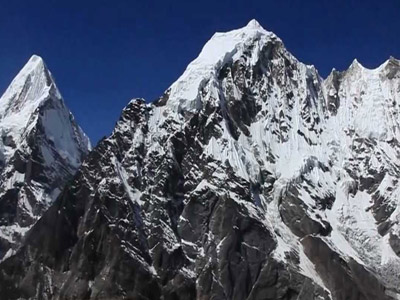
Makalu Base Camp Trekking
Duration: 20 Days
US$ 1750
